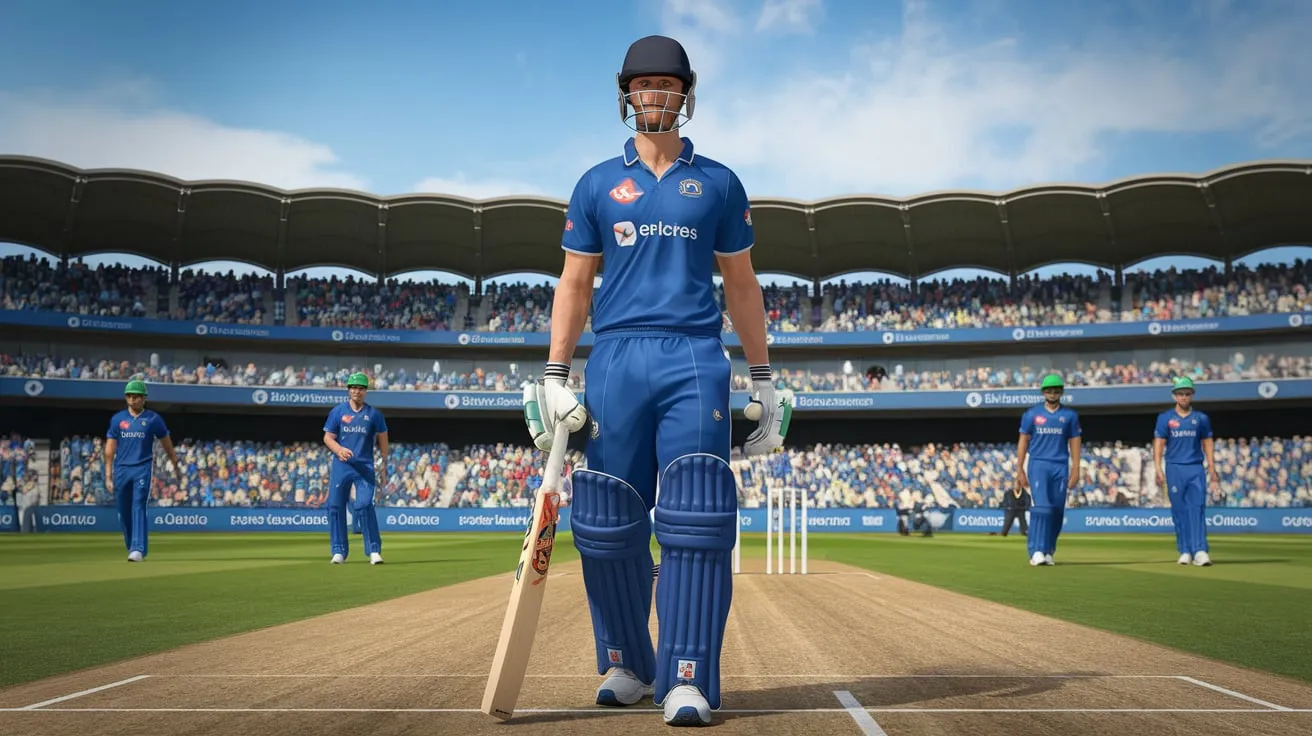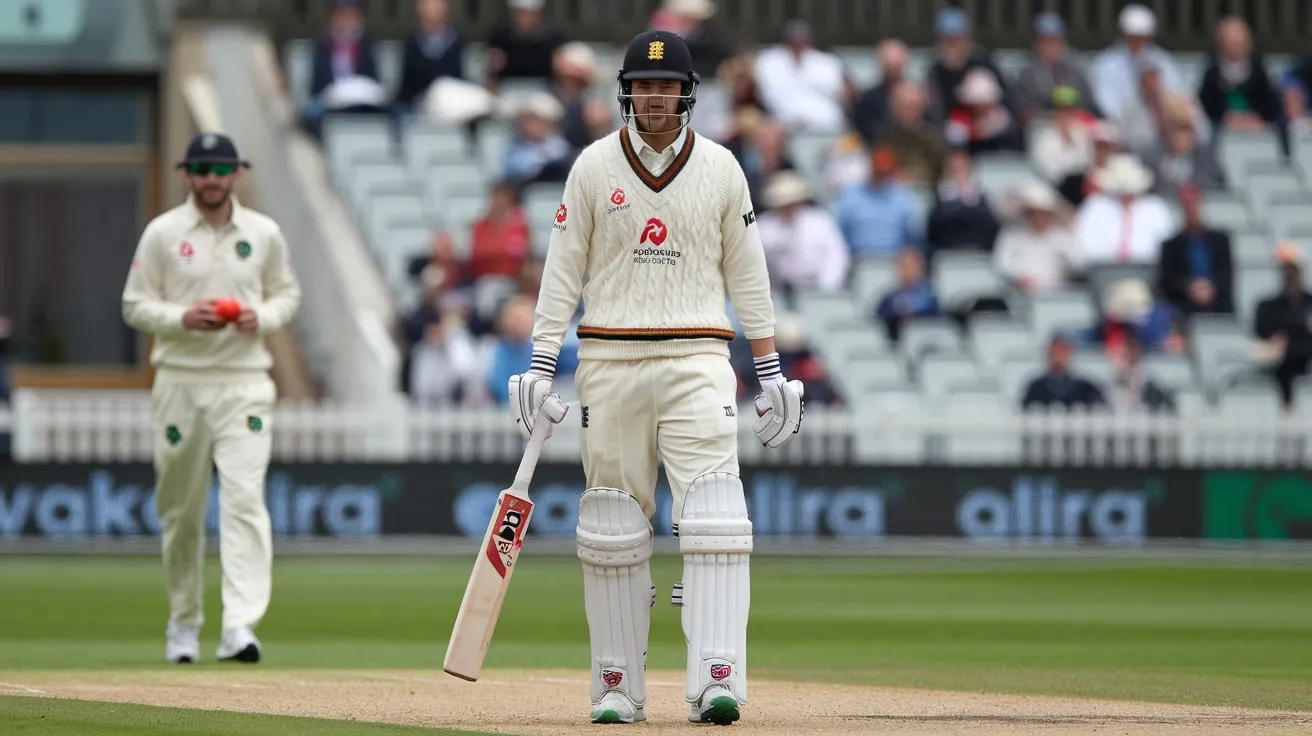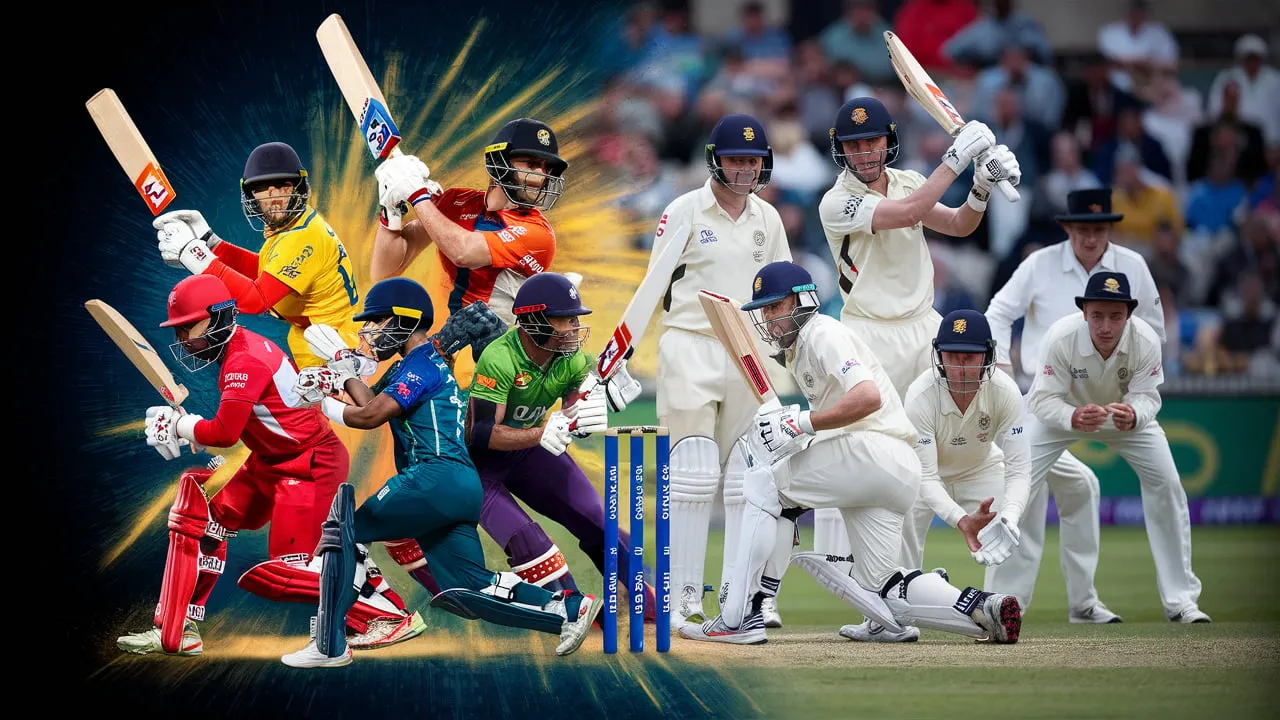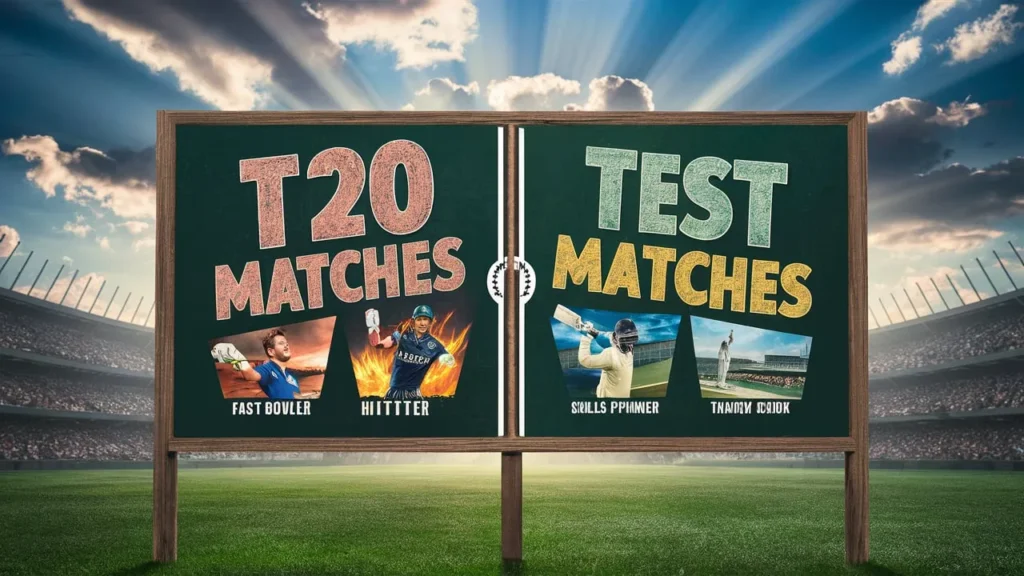T20 vs Test Matches spark lively discussions among cricket fans all over the globe, showcasing two unique formats that cater to different tastes and expectations. T20 matches, loved for their fast-paced excitement and thrilling finishes, typically wrap up within a few hours, focusing on aggressive batting and quick scoring. This format attracts a younger crowd looking for a quick adrenaline fix. On the other hand, Test matches offer a wonderful mix of strategy and endurance, stretching up to five days. They challenge players to showcase their skills, patience, and mental toughness as they navigate changing conditions and strong defenses. This article dives into the special features of each format, exploring their history, rules, and the types of players who shine in them. Whether you’re drawn to the electrifying vibe of T20 or the strategic richness of Test cricket, this guide will help you discover which format resonates most with your cricketing passion!

Introduce T20 Cricket and Test Matches
Cricket caters to every enthusiast with its diverse formats, each offering unique experiences to suit a variety of preferences. T20 cricket, known for its fast-paced and exhilarating action, captivates audiences with thrilling spectacles that keep fans on the edge of their seats. This format features short matches and high-scoring games, ensuring that every ball is crucial. Conversely, Test matches reveal the strategic depth and endurance inherent in the sport, often spanning five days and requiring patience and skill from the players.
By understanding the distinct characteristics of each format—such as gameplay nuances, rules, and player roles—you can deepen your appreciation for the game and discover where your true passion lies within the world of cricket. Whether you are drawn to the explosive excitement of T20 or the traditional battle of attrition seen in Test matches, there is a place for everyone in this beautiful game.
Duration and Pace
T20 matches typically last approximately three hours and involve each team facing only 120 balls during play. This format places a strong emphasis on immediate action and requires players to demonstrate quick thinking, adaptability, and rapid responses. Unlike traditional formats of cricket or lengthy games of hockey, where strategies can unfold over several hours, T20 matches encourage a fast-paced environment that keeps both players and fans on their toes. The shorter duration means every ball counts, making each decision critical, and often leading to exhilarating moments that highlight the athletes’ skills and instincts. This exciting blend of speed and strategy has contributed to the growing popularity of T20 cricket worldwide, captivating audiences with its dynamic play and thrilling finishes.
Test Matches: Lasting five days or longer, test matches are the pinnacle of cricket, providing a unique format that spans 90 overs each day across five sessions of play. This extended timeframe allows teams to meticulously strategize throughout long innings, testing not only players’ skills but also their mental fortitude. Captains must adapt their game plans based on the evolving conditions of the pitch and the performance of the opposing team. T20 vs Test Matches The significance of these matches extends beyond individual games, as they contribute to national pride and historical rivalries, making each contest a celebrated event in the world of cricket. Formulating winning strategies during a test match is a complex dance of patience and precision, where every decision can influence the outcome of the game.
Batting and Bowling Styles
T20 Cricket: Batsmen frequently adopt aggressive strategies when they step up to the crease in T20 and Test matches, aiming for high run rates to put pressure on the opposition. T20 vs Test Matches This often involves aggressive shot selection and calculated risks to maximize scoring opportunities within the limited overs. On the other hand, bowlers concentrate on containment and variation, employing a mix of pace and spin to outsmart the batsmen. T20 vs Test Matches Death bowling, which refers to the final overs of an innings, becomes crucial as bowlers try to limit runs while maintaining composure under pressure. This intricate balance between batting aggression and bowling strategy defines the thrilling nature of T20 cricket.
Test Matches: Batsmen who compete in Test cricket should focus on building both endurance and technique, as they need to face variable bowling spells over extended periods, often lasting up to five days. This requires mental resilience and strategic thinking to adapt to different bowlers and conditions throughout the match. T20 vs Test Matches On the other hand, bowlers aim for consistency in their deliveries while also exploiting pitch conditions, such as swing, spin, and seam movement, as key assets for their success. Mastering these elements can significantly influence the outcome of the match, making it crucial for both batsmen and bowlers to refine their skills continually.
Strategy and Tactics

T20 cricket strategies involve a combination of rapid scoring bursts and carefully planned field placements. Captains must make quick judgment calls in real-time, adapting their tactics based on the current match situation, player form, and even the conditions of the pitch. T20 vs Test Matches These decisions can significantly influence the game’s outcome, as teams aim to maximize runs while minimizing the opposition’s scoring opportunities. The fast-paced nature of T20 cricket requires players to be agile and responsive, making every moment crucial in the quest for victory.
Test Matches: Test match strategy typically involves multiple sessions of play spread across several days of intense competition. Captains employ intricate tactics designed to gradually wear down their opponents, seeking to exploit any weaknesses that emerge through a combination of wear-and-tear play and strategic maneuvering. T20 vs Test Matches This methodical approach often includes targeting specific bowler matchups, rotating bowlers to maintain pressure, and carefully managing batting order to build a solid foundation. Additionally, captains must remain vigilant in identifying gaps in the opposition’s defense, whether in field placements or bowling styles, allowing their team to seize opportunities for runs or crucial wickets. T20 vs Test Matches Success in these high-stakes contests requires not only acute foresight and patience from the captains but also the ability to adapt and respond to the evolving dynamics of the match, making Test cricket a true test of skill, strategy, and mental fortitude.
Entertainment Value
T20 cricket has long been popular for its high entertainment value, drawing in a diverse audience from avid fans to casual viewers. The format’s frenetic pace keeps everyone on the edge of their seats, with explosive batting leading to frequent boundaries that excite the crowd. The thrilling finishes, often filled with nail-biting tension and last-minute heroics, create memorable moments that resonate with spectators. T20 vs Test Matches This unique blend of excitement and drama makes T20 cricket not only a favorite among die-hard cricket enthusiasts but also an appealing spectacle for those new to the sport.
Test Matches: While they may seem less exciting at first glance, Test matches provide an extraordinary platform for intense battles and captivating narrative arcs that unfold gradually over the duration of each match, often lasting up to five days. These games captivate audiences not only with their strategic depth but also with the mental resilience displayed by players as they adapt to the challenges posed by the pitch and weather conditions. Fans are treated to a rich tapestry of skill, patience, and determination, as well as the evolving stories of team dynamics and individual performances that develop throughout the match. T20 vs Test Matches The beauty of Test cricket lies in its ability to engage and enthrall spectators, drawing them into a thrilling journey of competition that requires both physical prowess and mental fortitude.
Read More: Discover the exciting world of T20 cricket engagement, where fans come together to celebrate the fast-paced action and thrilling moments of this popular format. Learn more about its impact on communities and the sport’s growing popularity by clicking here: T20 Cricket Engagement
Global Notability and Audience Capture

T20 Leagues: These highly popular global leagues, particularly in India, Australia, and England, have revolutionized the cricketing landscape and attract a wide-ranging audience that includes families, young fans, and even seasoned cricket enthusiasts. With thrilling matches that feature some of the best players in the world, these leagues foster a vibrant atmosphere both in stadiums and through broadcasts, enhancing community engagement and sparking the love for the sport across different age groups. T20 vs Test Matches The blend of entertainment, music, and competitive cricket makes T20 leagues a favorite pastime for many, creating lifelong memories for fans.
Test Matches: Long held as the pinnacle of cricketing performance across nations like England, Australia, and South Africa, Test matches have maintained their esteemed status among fans and historians of cricket alike. T20 vs Test Matches These matches, which can last up to five days, are renowned for their unique format that emphasizes strategy, endurance, and skill. Each team has two innings, allowing for intense competition and the potential for dramatic comebacks. T20 vs Test Matches The rich history of Test cricket is filled with legendary players and unforgettable moments, showcasing the sport’s evolution and its deep-rooted traditions. Fans cherish the tactical battles on the field, as well as the camaraderie and rivalry that transcend borders, making Test matches a true celebration of the game.
Player Skills and Specialisation
T20 players often specialize in explosive batting, showcasing their ability to score runs quickly through powerful shots and innovative techniques. They excel in agile fielding, which allows them to make game-changing plays and stop boundaries with remarkable speed and precision.T20 vs Test Matches Additionally, these players master specific bowling variations designed for short formats, such as yorkers, slower balls, and bouncers, enabling them to outsmart batsmen and adapt to the fast-paced nature of the game. Their skills are crucial in creating exciting moments and ensuring competitive matches in the thrilling world of T20 cricket.
Test Matches: Cricketers excel in various aspects of the game, showcasing remarkable endurance that allows them to perform at their best over long matches. Their technical ability is honed to handle both swing and spin batting styles, requiring a deep understanding of the game and exceptional hand-eye coordination. T20 vs Test Matches additionally, they demonstrate sustained bowling accuracy, maintaining precision over extended spells of playing time, which is crucial for building pressure on the opposing team and achieving success on the field. This combination of skills not only highlights their athleticism but also their strategic thinking and adaptability in different match situations.
Impact on Player Careers
T20 cricket offers exciting career opportunities through various global leagues, such as the Indian Premier League (IPL), which showcases talent on an international stage. These leagues not only enhance players’ visibility but also provide substantial financial rewards, attracting top talents from around the world. T20 vs Test Matches However, while the fast-paced nature of T20 cricket can lead to lucrative contracts and a wider fanbase, it may also come at the cost of traditional Test cricket skills, as players prioritize shorter formats over the longer, more strategic gameplay. Balancing the demands of T20 with the nuances of Test cricket becomes a vital consideration for aspiring cricketers.
Test Matches: Test cricket remains at the pinnacle for many players, as it is not only the longest and most traditional format of the game but also a true test of skill and endurance. It provides an invaluable opportunity to showcase resilience, temperament, and the ability to perform under pressure over multiple days. Players must navigate varying pitch conditions, weather changes, and the mental challenges of maintaining focus throughout long innings. T20 vs Test Matches This format allows cricketers to demonstrate strategic thinking, adaptability, and teamwork, as they work collectively to outlast and outsmart their opponents in a battle that unfolds over five days. For many, excelling in Test cricket is the ultimate achievement, reflecting their mastery of the sport.
Comparing T20 Match Results

Results in T20 cricket can often hinge on singular moments or standout performances, where a brilliant catch, a spectacular boundary, or a crucial wicket can dramatically shift the momentum of the game. T20 vs Test Matches This unpredictability frequently leads to tight finishes that keep fans on the edge of their seats, or sudden collapses that can leave a team reeling. Such pivotal moments underscore the exhilarating nature of T20, where the stakes are high and anything can happen within the span of just a few balls.
Test Matches: Drawing is always a possibility during test matches, a format that emphasizes the importance of patience and perseverance. T20 vs Test Matches Players must navigate challenging conditions, such as unpredictable weather and varying pitch circumstances, all while facing resilient opponents who are equally determined to succeed. The strategic nature of test cricket often leads to intense battles, where both teams must remain focused and adaptable, understanding that a draw can be a valuable outcome in the pursuit of victory over a prolonged contest.
Fan Engagement and Experience
T20 Cricket: Fans relish the immediate action and global reach of T20 cricket, which combines high-energy gameplay with an electric atmosphere. At stadiums, spectators interact directly with the game, cheering for their favorite teams and players, creating a sense of community and excitement. T20 vs Test Matches Meanwhile, global broadcasts enhance the experience, allowing fans from all corners of the world to tune in, share their thoughts on social media, and engage in lively discussions. This unique blend of in-person and remote participation adds an extra layer of thrill to the sport, making T20 cricket a truly global phenomenon.
Test Matches: Fans deeply treasure the rich traditions and compelling narratives that surround Test cricket. These include not only the fierce rivalries between teams that have spanned generations but also the legendary performances that have etched themselves into the annals of sports history. T20 vs Test Matches Such moments create lasting emotional connections for viewers, as they witness extraordinary displays of skill, perseverance, and sportsmanship during these iconic contests. Whether it’s a dramatic last-wicket stand or a breathtaking innings, every match adds to the lore of Test cricket, making it a cherished experience for all who follow the game.
People Also Ask
- What are the key differences between T20 and Test cricket? Test cricket is the longest format, played over five days, focusing on endurance, patience, and strategic depth. T20 matches, on the other hand, last about three hours and emphasize aggressive, high-paced action, making them more entertaining for short attention spans.
- Why do some players excel more in Test matches than in T20s? Test cricket demands resilience, technique, and consistency over long periods. Players like Cheteshwar Pujara excel here due to their ability to defend and bat patiently. In contrast, T20 cricketers like Andre Russell thrive with quick reflexes and explosive hitting abilities, which are less relevant in Tests.
- Which cricket format is better for beginners to follow? For new fans, T20 cricket is easier to understand and more exciting due to its fast pace and dynamic style. Test cricket, however, appeals to those who appreciate the strategic nuances and history of the game but can be challenging for beginners to follow across five days.
- Can players master both T20 and Test cricket skills simultaneously? Yes, several modern players, like Virat Kohli and Ben Stokes, have successfully adapted their skills to excel in both formats. However, balancing these formats requires immense versatility—batters need to shift between aggressive shot-making and defensive play, while bowlers adjust to shorter or longer spells.
Conclusion
Choosing between T20 and Test matches ultimately hinges on your viewing preferences and cricketing temperament. T20 matches are celebrated for their fast-paced, high-energy action, making them ideal for fans who revel in quick thrills and explosive performances. T20 vs Test Matches In contrast, Test matches provide a more strategic and nuanced experience, appealing to those who appreciate the traditional elements of the game and the endurance challenge it presents.
Both formats offer compelling reasons to watch, significantly enhancing cricket’s global allure and creating unforgettable moments of entertainment that resonate with fans worldwide. T20 vs Test Matches Whether you favor the adrenaline rush of a T20 or the intricate storytelling of a Test match, there’s something to captivate every cricket enthusiast.
FAQs On T20 vs Test Matches
In Case You Missed
- Best Fantasy Cricket Strategies Discover effective strategies that can help you dominate your fantasy cricket league, including player selection tips, match-up analysis, and how to leverage live stats to your advantage.
- Top 5 Fantasy Football Tips for Beginners A comprehensive guide for newcomers to fantasy football, covering essential tips such as understanding scoring systems, drafting strategies, and how to manage your team throughout the season for optimal performance.
- Best Fantasy Football Sleepers Uncover hidden gems in the fantasy football world! This guide highlights lesser-known players who have the potential to outperform expectations, giving you an edge in your league.




